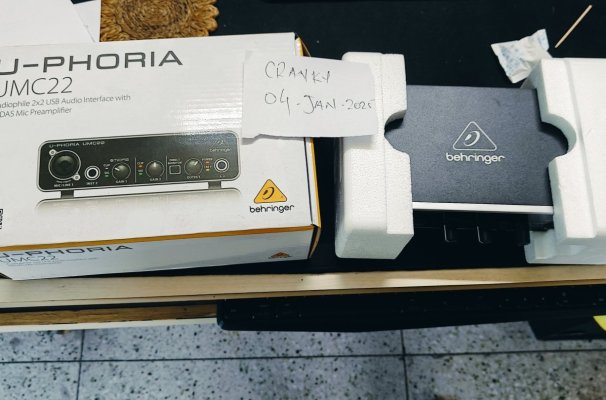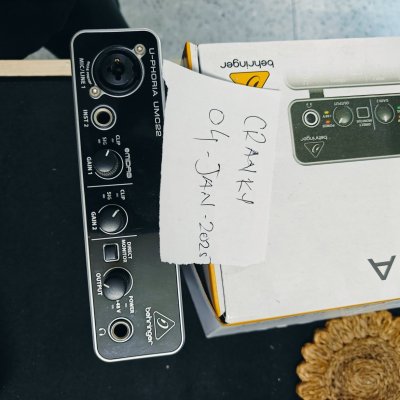- Expected Price (Rs)
- 3000
- Shipping from
- Kolkata
- Item Condition
- 3 out of 5
- Payment Options
- Cash
- Bank Transfer
- Purchase Date
- Oct 20, 2019
- Shipping Charges
- Excluded - at actuals
- Have you provided two pics?
- Yes
- Remaining Warranty Period
- None
- Invoice Available?
- No
- Reason for Sale
- No longer needed
Behringer UMC22, purchased 2019, good condition, no scratches though wear is visible.
 www.behringer.com
www.behringer.com
Used only rarely with Windows, primary use case was for internet radio streams played on an assortment of Raspberry Pis.
No longer needed, hence putting on sale. Device is in good condition and works fine. Original USB A to B cable is included, still in sealed condition as I use aftermarket cables only. Not other cables are sold with the unit and I will not be including any. It has TS jacks at the back (6.35mm) and a stereo headphone jack on the front, also 6.35mm.
Please familiarise yourself with the capabilities and limitations of the device before buying. Julian Krause has a good video with proper measurements for home studio and podcast users.
This is a USB 1.1 device and uses sync data transmission, hence small clock errors can cause complete misalignment of the clock edges to the audio data, causing the static that Julian experienced. It is usually solved by unplugging and reattaching the device. In the time I was using it, I did experience it only once, when it had been continuously attached to a Raspberry Pi and playing background radio for about six days, and on the sixth day it decided to take a break. It has not misbehaved before or since, though as normal Linux and iOS will be more stable than Winblows.
Can ship at buyer's risk and expense in the factory box (also in good condition), though I find it's better/cheaper when the buyer organises shipping.
Short video to demo the unit is available for interested buyers, along with the Edifier R1280T which is also on sale.
Behringer | Product | UMC22
Used only rarely with Windows, primary use case was for internet radio streams played on an assortment of Raspberry Pis.
No longer needed, hence putting on sale. Device is in good condition and works fine. Original USB A to B cable is included, still in sealed condition as I use aftermarket cables only. Not other cables are sold with the unit and I will not be including any. It has TS jacks at the back (6.35mm) and a stereo headphone jack on the front, also 6.35mm.
Please familiarise yourself with the capabilities and limitations of the device before buying. Julian Krause has a good video with proper measurements for home studio and podcast users.
This is a USB 1.1 device and uses sync data transmission, hence small clock errors can cause complete misalignment of the clock edges to the audio data, causing the static that Julian experienced. It is usually solved by unplugging and reattaching the device. In the time I was using it, I did experience it only once, when it had been continuously attached to a Raspberry Pi and playing background radio for about six days, and on the sixth day it decided to take a break. It has not misbehaved before or since, though as normal Linux and iOS will be more stable than Winblows.
Can ship at buyer's risk and expense in the factory box (also in good condition), though I find it's better/cheaper when the buyer organises shipping.
Short video to demo the unit is available for interested buyers, along with the Edifier R1280T which is also on sale.



